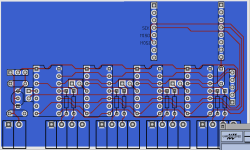OK, I've wasted a few hours this afternoon working on a derivative of the px11 controller from a few years back. This board is roughly 2" x 3" with 4 14-pin PICs (of which there are about 8 different parts that could be used) and a Wemos Mini D1. The default build would support up to 1200 pixels (4 output channels of up to 300 pixels each). One major benefit of this design is that it would be totally open-source (including placing the gerber files in the open OshPark library), so that people would not be as dependent on various storefronts in this era of supply-chain problems.
Obviously this board design might want some refinement, and I'm not going to do much more with it until and unless there becomes a need for it (hopefully not). The PIC firmware would be an easy modification to the PX11 firmware, and hopefully the Wemos software could be easily ported from current designs. Anyway, it's something that might be worth thinking about.
Obviously this board design might want some refinement, and I'm not going to do much more with it until and unless there becomes a need for it (hopefully not). The PIC firmware would be an easy modification to the PX11 firmware, and hopefully the Wemos software could be easily ported from current designs. Anyway, it's something that might be worth thinking about.


